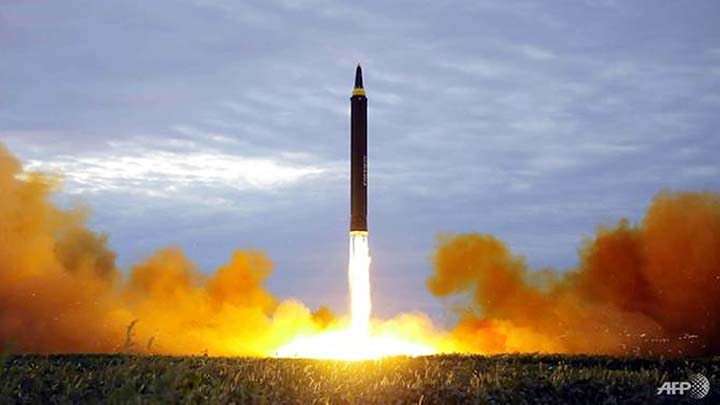
The Telegraph :
North Korea fired two short-range missiles into the sea early on Thursday from its eastern coast, in a sign of its growing impatience with the lack of progress in talks with Washington over its nuclear weapons programme.
The South’s Joint Chiefs of Staff said the missiles that were fired from near the eastern coastal town of Wonsan flew about 270 miles before landing in the waters off the country’s east coast.
A South Korean defence official told AP that an initial analysis showed both missiles were fired from mobile launchers and flew at a maximum altitude of 30 miles.
Some analysts speculated that it could be the test of a KN-23, a “quasi ballistic missile.”
A senior US official said the Trump administration was aware of the reports of a short-range projectile launched from North Korea. The official said the administration had no further comment at this time.
South Korean Defence Ministry spokeswoman Choi Hyunsoo urged Pyongyang to stop acts that are “not helpful to efforts to ease military tensions on the Korean Peninsula.”
If North Korea fired ballistic missiles, it could have ramifications because UN Security Council resolutions ban the North from engaging in any launch using ballistic technology. Still, the UN Security Council has typically imposed fresh sanctions on North Korea only when it conducted long-range ballistic missile tests.
“If they were ballistic missiles, they violate the UN sanctions, and I find it extremely regrettable,” Japan’s Defence Minister Takeshi Iwaya told reporters in Tokyo.
The launch was the first weapons test since Donald Trump, the US president, took a historic few steps into North Korea at its heavily armed border with the South in Panmunjom late last month, and indicates that the unprecedented gesture did not win much capital with Pyongyang.
The leaders agreed to resume talks to disarm Kim Jong-un’s nuclear and missiles programme, which Mike Pompeo, the US secretary of state, said would likely begin in mid-July when the two sides had agreed their negotiating teams.
However, tensions escalated again last week when North Korea threatened to call off its suspension of its 20-month nuclear and missile tests, and the talks remain deadlocked.
The warning pre-empted a planned joint US-South Korea military exercise in August, which it called “a rehearsal of war, aimed at militarily occupying our Republic by surprise attack.”
A Pyongyang foreign ministry statement said Mr Trump had pledged to suspend the military drills at his first historic summit with Kim Jong-un in Singapore last year, which he reiterated at their short meeting on the border.
It added: “With the US unilaterally reneging on its commitments, we are gradually losing our justifications to follow through on the commitments we made,” stressing the military drill would also affect talks if it went ahead.
North Korea has shown increasing signs of dissatisfaction with the direction of its relations with the US and South Korea since a summit between Kim and President Trump in Hanoi in February ended in failure.
North Korean leader Kim Jong Un visits a submarine factory in an undisclosed location, North Korea Credit: Reuters
North Korean leader Kim Jong Un visits a submarine factory in an undisclosed location, North Korea Credit: Reuters
It also tested weapons in May, including both short-range missiles as well as smaller rockets. At the time, Kim oversaw the first flight of a previously untested weapon – a relatively small, fast missile experts believe will be easier to hide, launch and manoeuvre in flight.
On Tuesday, North Korea’s state news agency KCNA reported Kim inspected a large, newly built submarine, accompanied by missile programme leaders. It potentially signalled continued development of a submarine-launched ballistic missile (SLBM) programme.
Vipin Narang, a securities professor at MIT, tweeted that “if it is KN-23, it isn’t long range and ROK (South Korea) can still call it a “quasi ballistic missile”, so Kim can go tit-for-tat with impending exercises while Trump and Moon live in denial.”
He added: “What it does show..is Trump’s trip to Panmunjom may not yet have had its desired effect.”
It also tested weapons in May, including both short-range missiles as well as smaller rockets. At the time, Kim oversaw the first flight of a previously untested weapon – a relatively small, fast missile experts believe will be easier to hide, launch and manoeuvre in flight.
On Tuesday, North Korea’s state news agency KCNA reported Kim inspected a large, newly built submarine, accompanied by missile programme leaders. It potentially signalled continued development of a submarine-launched ballistic missile (SLBM) programme.
Vipin Narang, a securities professor at MIT, tweeted that “if it is KN-23, it isn’t long range and ROK (South Korea) can still call it a “quasi ballistic missile”, so Kim can go tit-for-tat with impending exercises while Trump and Moon live in denial.”
He added: “What it does show..is Trump’s trip to Panmunjom may not yet have had its desired effect.”

